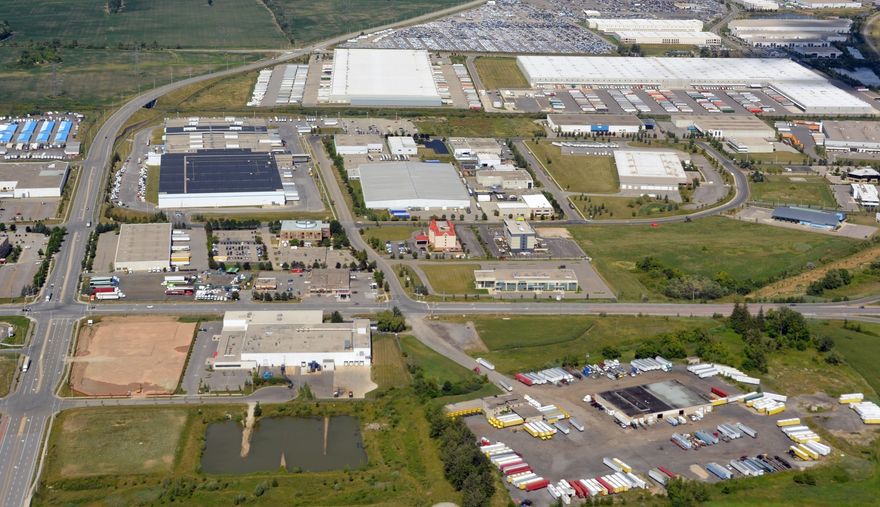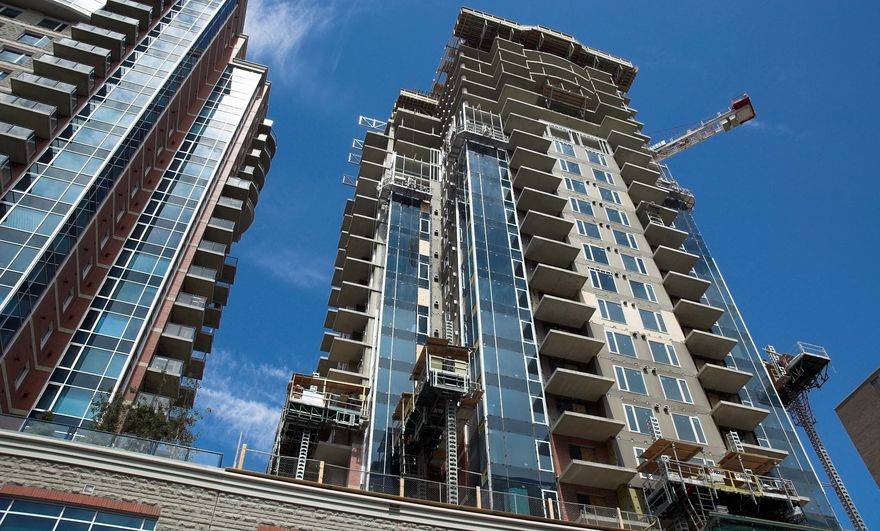Like most realms of real estate, the commercial real estate world is going with the ebbs and flows of interest rates, which hit a high of 5.00% in 2023 – a rate not seen in over two decades.
As we enter 2024, the consensus among experts now appears to be that the Bank of Canada will start lowering its policy interest rate around the midpoint of the year.
With that in mind, STOREYS spoke to commercial real estate brokerages across the country to get a sense of the current state of the office, industrial, retail, and multi-family markets, as well as what to expect should we indeed see interest rates drop.
Office
According to Altus Group, a total of 56 office projects were under construction across Canada as of Q4 2023, totalling to over 10,500,000 sq. ft — nearly 92% of which is in Toronto and Vancouver — with an estimated 52% of that space pre-leased.
Canada’s office sector will likely remain “sluggish,” Altus Group says, without any drastic changes from the past few years. To find success, landlords will likely need to offer generous incentives in order to acquire tenants or provide valuable amenities for them, giving tenants more bargaining power.
An office market report published by CBRE earlier this month also notes that there is an increasing “bifurcation” of office space across the country, with clear delineations between Class A and Class B buildings, with demand for quality spaces noticeably higher for Class A buildings and vacancies rising for Class B buildings, particularly in downtown cores.
READ ALSO: Real Estate Expert Tina Walters Advocates Restructuring in Nigerian Rental Market Post-Pandemic
Damon Conrad, National Managing Director for Royal LePage Commercial, says that he has seen that, too, and that there is a “significant discrepancy and a dichotomy” between the different classes of office buildings, as well as between downtown and suburban markets, with the latter showing strength. He adds that he also expects construction starts to be low this year.
“Construction [starts] are either being spaced out or completely taken off the books — although we haven’t seen too many projects cancelled completely,” he says. “It’s just a matter of trying to wait it out a little bit, waiting for construction costs to level out more, waiting for interest rates to drop, presumably near the end of Q2. So, office, I’d say, remains status quo.”
It remains to be seen whether owners of office assets will make the decision to sell their properties, with a survey of lenders conducted by CBRE in late November finding “uncertainty surrounding office valuations” to be a major challenge for many, resulting in few points of comparison. Hence, many have their eye on the two office buildings in downtown Vancouver that Oxford Properties has put up for sale, as reported by STOREYS in June, as their sales would provide a sense of how office assets are currently being evaluated.

The two office buildings Oxford Properies has listed for sale in downtown Vancouver, at 402 Dunsmuir and 401 W Georgia. (Oxford Properties, B+H Architects)
A combination of the above could potentially push many property owners towards office conversions, several people interviewed for this article say, in order to preserve the value of the assets. Financing those projects, however, will be a big factor in whether those conversions happen, but could be aided if local governments introduce incentive programs, following in the footsteps of Calgary.
Industrial
“Demand has not waned in Canada’s industrial sector,” says Altus Group. “Despite elevated interest rates and inflationary pressures, investors continued to favour the asset class for its minimal risk and stable returns.” For some, industrial assets have also become a hedge against inflation.
In Q4 2023, the national availability rate for industrial space increased by 0.7% to 4.3%, with minor increases in all major markets, but that was primarily a reflection of the 16,300,000 sq. ft of new space that completed in the quarter — well above typical 10,000,000 sq. ft or less for the final quarter of the year — and demand is still outpacing supply.
Not dissimilar to the shift to remote work, the retail sector is increasingly seeing a shift to e-commerce, increasing the demand for industrial space, whether it be warehouses or distribution centres. In the coming year(s), demand for modern industrial spaces will likely continue to trend up, particularly in suburban outskirts of major markets, and investors are likely carrying “cautious optimism” heading into 2024.

An industrial area in Milton, Ontario. (Shutterstock)
“The office and industrial market both finished 2023 relatively quiet and relatively slow in terms of activity,” says Susan Thompson, Associate Director of Research for Colliers, who adds that both are now tenants’ markets, meaning those looking for space should have a decent amount of options and plenty of time and leverage to consider them.
“With industrial, we would consider a balanced market to be in that 3% to 5% range,” says Thompson. “Some markets are starting to bump up against the bottom of that, but that’s kind of a good thing, because you need that level of vacancy to provide options for tenants — to grow, to relocate, to come into the market. A lot of that has been constrained for a long time.”
Jason Kiselbach, Managing Director of CBRE Vancouver, agrees that a slight vacancy rate increase in tight markets such as Vancouver is healthy and gives tenants options. He adds that an oversupply is also not a huge concern or a big likelihood in markets like Vancouver, given development constraints that prevent new projects from being built quickly.
Retail
Regarding retail, lenders surveyed by CBRE identified the asset type as a middle-tier in terms of risk — lower than office, land, and hotels; higher than purpose-built rental and industrial — but there are also some delineations between different kinds of retail assets, primarily between big regional malls and smaller grocery-anchored retail. The former was identified as an asset of concern by over 70% of respondents, while the latter was identified by less than 10%.
“I’m actually relatively bullish on retail,” Conrad, of Royal LePage Commercial, says. “The consensus seems to be that retail has survived COVID really well in certain areas, and bounced back a lot faster than some imagined. I did a survey recently at a conference we had, a Royal LePage Commercial symposium, and I asked 100 people in the room ‘How many of you, in the last three months, have done a curb-side pick-up at a mall?’ — which we anticipated at one point was just going to be the way business was done going forward. Not one person put their hand up. People have returned to brick-and-mortar. They’ve returned back to the malls.”

The plaza at the new Amazing Brentwood mall in Burnaby, BC. (Shutterstock)
Conrad says that a big focus of retail landlords now is increasing “dwell time” — the amount of time consumers spend in the space. For others, retail properties are also increasingly receiving attention as sites for future residential development, particularly older open-air shopping centres like the 123,000-sq.-ft Panorama Village shopping centre in Surrey, British Columbia that was sold earlier this month.
A retail market report published by Colliers last month also notes that because consumer confidence is declining, we can also expect to see a decline in discretionary spending, while spending on necessities — grocery stores, pharmacies — will continue to excel for at least the next two years.
Kiselbach, of CBRE, agrees that retail has been a fairly stable asset class over the past few years, benefiting from the fact that there is not a lot of new retail space being built. Leasing demand has been healthy and rental rates have increased, he notes, and he has seen some “renewed interest” in buyers looking to just hold onto retail assets and not just acquiring them for redevelopment.
Multi-Family
“Multi-family land, I think, is going to have a significant rebound year,” says Conrad. “There’s pent-up demand and you can sit and wait only for so long before you have to act.”
He adds that what he has heard from developers he has spoken to, and what Royal LePage Commercial’s agents have heard from their clients, is that developers are looking for stability and clarity.
“We’re anticipating that there’s probably going to be a little more stability this year, and that people are going to know what they’re working with and what they’re dealing with, and they’re going to plan accordingly after that,” says Conrad.

Luxury condos under construction in Calgary, Alberta. (Shutterstock)
The multi-family market is more sensitive to government policy, multiple people interviewed for this article note, so activity can vary from market to market. It’s unclear how much of an impact the federal government’s decision to eliminate GST on new rental construction will really have, says Cory Wright, Managing Director of Vancouver-based William Wright Commercial, as local development costs — DCCs, CACs — will likely eat away at those savings.
“But there’s record immigration, it takes forever to build stuff, demand is going to continue to grow, and I think multi-family will be a leader as an asset in the commercial real estate realm,” adds Wright. “Obviously prices have come off, but I think you’re seeing a lot more activity now [as of December] in land transactions than what we were seeing even five months ago.”
“Companies, and institutions, and REITs, they’re looking more for stability than relief, if that makes sense. Stability being ‘We’ve peaked on rates, if I have to approve my cap stack to get the property at maybe a slight discount and I can make these numbers work, we’re going in.’ Because last time I checked, there isn’t any more land, and that’s why I think you’re going to have demand continue to swell in 2024 and 2025.”
CBRE’s survey found that 74% of lenders who were surveyed intend to increase their budgets for purpose-built rentals, 80% of them believe that purpose-built rental have a “low/normal” amount of risk in 2024, and no lenders identified purpose-built rental as an asset of concern.
For those involved in developing condominiums, 72% lenders who were surveyed stated that they are now tightening lending conditions by requiring greater upfront equity in projects. Of those surveyed, 39% also said that they are shifting towards greater deposit requirements and shorter payment schedules, while 22% are scaling back sizes of projects.
All this is to say that Canada is deeply amidst a housing crisis and building more purpose-built rental stock might be the best way out of it.
Source: Storeys



